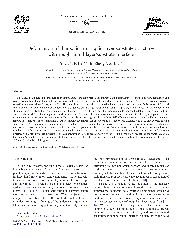摘要
This paper investigates the consequence on deformation of the compressive solid film in a laminate structure with thin solid film, liquid layer and rigid substrate from top to bottom, by taking consideration of the roughness in the liquid layer/substrate interface. Two roughness morphologies, self-affine and mound roughness, are studied. The solid film corrugates when subjected to internal compressive stresses. Deformation of the solid film is determined by calculation of energies in this structure. Our analogy indicates that rough morphologies may affect the deformation of the structure. Interestingly, further investigation shows that the solid film with nonplanar liquid/substrate interface can be stable under certain wrinkling wave numbers, while that with a planar liquid/substrate interface under the same wave numbers can be unstable. Our findings supplement rather than overthrow the previous theory obtained without considering the roughness in interfaces. Self-affine interface is characterized by ail roughness amplitude A, and the fractal dimension s. As for mound roughness, the characteristic parameters are interface width omega, and average mound separation lambda. With increasing amplitude or interface width of a rough interface, the roughness in interface exhibits more influence on the stability of the structure. Variation of critical wave numbers increases in parallel to the increase of fractal dimension s in the structure with a self-affine roughness interface, or decrease of the average mound separation in the structure with a mound rough inter-face. The influence of the rough interface on the stability of the structure reach to a plateau when s or lambda is large enough or when lambda is little enough. As sequences, the stable state when the vicious/substrate interface is supposed to be planar is very different from that when the interface is nonplanar for both rough morphologies.
- 出版日期2006-8-14
- 单位同济大学
